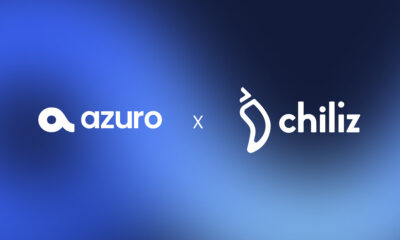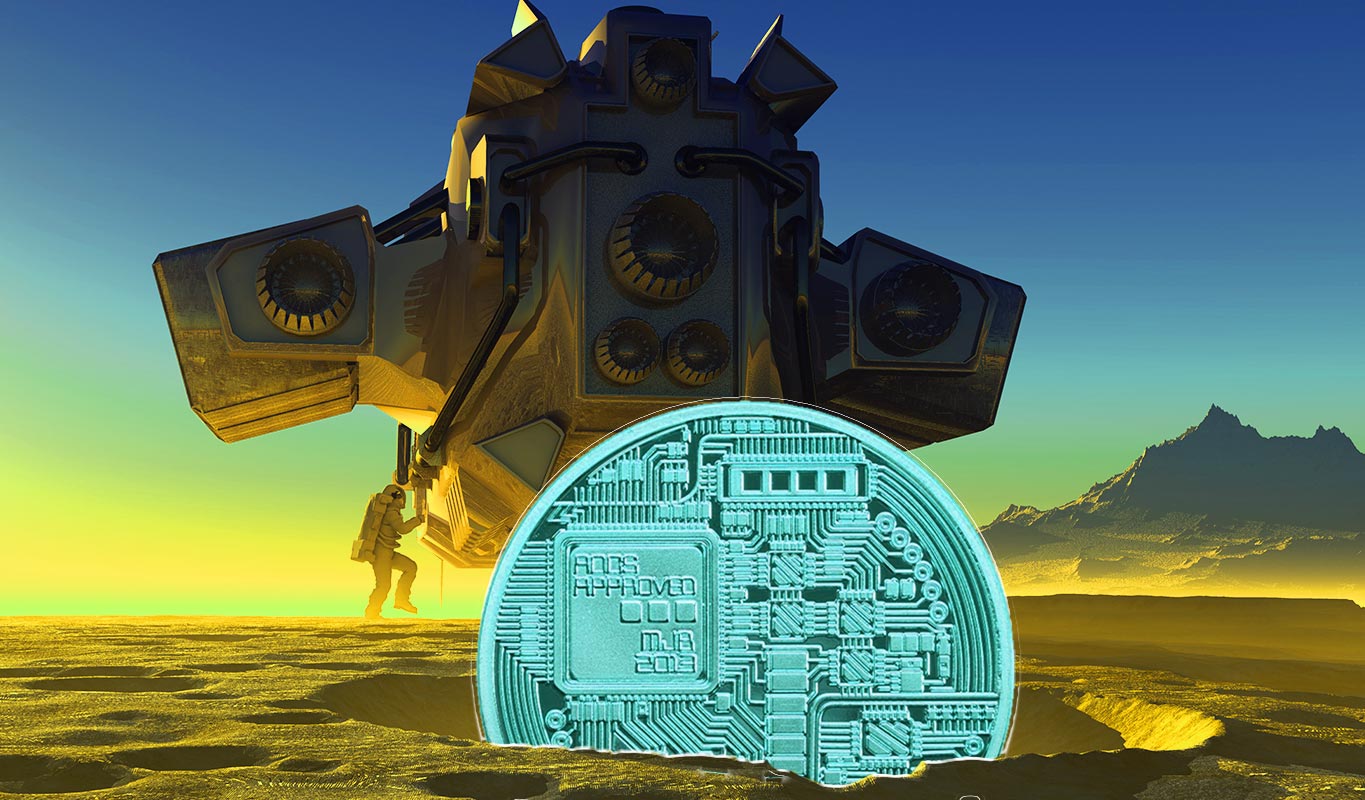HodlX
Why Bitcoin’s Limited Supply Is Foundational to the Current Surge
Published
2 months agoon
By
admin
HodlX Guest Post Submit Your Post
Of the many breakthroughs that Satoshi gave us with Bitcoin, its hard-capped supply and programmatic issuance have always been most captivating to me.
Unlike any other money the world has ever seen, it is impossible to create more of it than the supply schedule dictates.
New Bitcoins are issued every 10 minutes as ‘block rewards’ given to miners as payment for securing the network.
Roughly every four years (210,000 blocks), Bitcoin’s supply issuance is reduced by 50% in an event known as the ‘halving,’ which is set to occur this year around April 20.
The brilliance of this programmed scarcity can be explained with basic supply and demand economics.
Like any new technology, Bitcoin adoption increases with network effects.
As people around the world learn about Bitcoin and want to use it to store and send value to each other, demand for the asset increases exponentially as more people come to the network.
Meanwhile, on the supply side, the amount of Bitcoin being issued every four years is decreasing due to the halving event.
Miners are paid fewer Bitcoin per block and therefore have less to sell to offset their infrastructure costs of securing the network.
The current block reward is 6.25 Bitcoin (900 per day), which will reduce to 3.125 Bitcoin (450 per day) at the halving.
More demand seeking out decreasing supply brings price appreciation, as the only way to acquire Bitcoin is to increase the notional price and incentive for existing holders to part with their Bitcoin.
The SEC approval of the spot Bitcoin ETF and the ease for new capital to access the Bitcoin market has shown these supply and demand mechanics at work.
In less than two months, the Bitcoin ETF launch has shattered all historical precedence for the debut of an ETF product with the cumulative trading volume across all issuers surpassing $141.7 billion.
For perspective, Bitcoin ETF inflows over the past two months have exceeded inflows into all gold ETFs in the past five years.
Even more remarkable, the volume of Bitcoin acquired daily through the ETF is accelerating with net inflows for the week ending March 15, reaching a record $2.57 billion.
Since launch, the ETF has seen average inflows nearly three-and-a-half times larger than the cumulative daily block reward – and ETF demand recently surged to seven-and-a-half times the cumulative daily block reward.
Extrapolating those numbers out post-halving, even with no further acceleration, and we’ll see ETF demand for Bitcoin 15 times larger than the new coins being provided by the network by the block subsidy.
As a result of basic economics, the increase of demand to the market with fixed supply issuance has dramatically impacted the price of Bitcoin, which has increased approximately 61% since ETF approval, at the time of writing, bringing the asset to new all-time highs in US dollar terms.
Appreciation of Bitcoin’s price works as its best marketing tool, as price increases bring more media coverage and more people talking, ultimately drawing more eyes and interest to Bitcoin.
The flywheel of adoption turns faster, resulting in even more price appreciation and the beginning of a new Bitcoin bull market.
While it drives headlines to make price predictions for Bitcoin based on the performance of other Bitcoin bull cycles, I believe such forecasts are misguided.
Never in Bitcoin’s history have we had buying behavior, demand and incentives that can be compared to what we’ve seen with these new ETF products.
Firms like Fidelity and BlackRock are not just using their massive marketing machines to bring their ETFs to customers – they’ve placed them as baskets in their ‘all-in-one funds’ to boost returns.
These funds are automatically contributed to in vehicles like 401ks, IRAs and pensions, bringing a consistent buyer of scale to Bitcoin of the likes that we’ve never seen.
As these funds perform better as a result of Bitcoin’s inclusion, competing funds will have to follow suit to ensure they don’t lose their customer base and increase allocation percentages to bring greater returns.
Expecting Bitcoin price performance to act the same way it has in prior cycles with different participants is likely a mistake.
We have buyers who behave differently, and we won’t truly understand their impact until they’ve weathered another cycle or two.
While there will of course be leverage and speculation with any market cycle, I believe this time it is different.
We’ll see a cascade of corporates, institutions, governments and sovereign wealth funds enter the space as the ETF has brought the asset class both legitimacy and accessibility.
Firms like Microstrategy are showing the game theory Satoshi designed at work, as their first mover advantage to using Bitcoin as their treasury asset has brought a 333% return to the stock in the last six months.
Other CEOs and board members are taking note, with their compensation packages tied to stock performance, and there will be other dominos to fall as a result.
As Satoshi designed, this is basic supply and demand principles at work at a grand scale, and we’re watching the repricing of Bitcoin in real time.
The largest capital allocators in the world are now pawns in Satoshi’s game theory, not wanting to miss out on the first mover advantage to their peers that they’re measured against.
It’s a privilege to be a spectator in such fascinating times as the world wakes up to the significance of scarcity.
Mitch Kochman is the director of platform sales at BitGo, where he manages BitGo’s premier client relationships with exchanges, miners and payments platforms. He is predominantly focused and passionate about the Bitcoin-only ecosystem. Mitch has been with BitGo since 2022 and previously spent 11 years at IBM as a sales executive leading global software strategy at several major banks, the last of which being J.P. Morgan Chase.
Follow Us on Twitter Facebook Telegram

Disclaimer: Opinions expressed at The Daily Hodl are not investment advice. Investors should do their due diligence before making any high-risk investments in Bitcoin, cryptocurrency or digital assets. Please be advised that your transfers and trades are at your own risk, and any loses you may incur are your responsibility. The Daily Hodl does not recommend the buying or selling of any cryptocurrencies or digital assets, nor is The Daily Hodl an investment advisor. Please note that The Daily Hodl participates in affiliate marketing.
Featured Image: Shutterstock/delcarmat
Source link
You may like


Insight Into The Timing And Factors


Bitcoin About To ‘Blow Higher’ Despite This Week’s Pullback, According to Glassnode Co-Founders – Here’s Why


Azuro and Chiliz Working Together to Boost Adoption of Onchain Sport Prediction Markets – Blockchain News, Opinion, TV and Jobs


Robinhood Bleeds 164 Million Dogecoin


AIGOLD Goes Live, Introducing the First Gold Backed Crypto Project – Blockchain News, Opinion, TV and Jobs


Analyst Benjamin Cowen Warns Ethereum ‘Still Facing Headwinds,’ Says ETH Will Only Go Up if Bitcoin Does This
HodlX
Why the US Should Reevaluate Its Approach to the Bitcoin Mining Industry
Published
1 month agoon
April 12, 2024By
admin
HodlX Guest Post Submit Your Post
Bitcoin mining has garnered a reputation for being wasteful and dirty though this couldn’t be further from the truth.
Bitcoin mining can be as ‘green’ as any industry and is an essential aspect of Bitcoin overall.
After Bitcoin mining was banned in countries such as China and others, it caught on in a big way in the US, quickly becoming a major industry with a notable presence in towns across the US.
Cryptocurrency mining – the vast majority of which is Bitcoin mining – requires between 0.6% and 2.3% of all electricity used in the US.
And globally it requires between 0.2% and 0.9% of all power – as much as Greece and Australia.
The carbon footprint of mining in the US is 78.7 million metric tons of CO2 per year. The industry is growing so fast that regulators are moving to understand it better.
The US EIA (Energy Information Administration) moved to require cryptocurrency mining businesses to share power usage details and has considered fines against miners.
The EIA has faced legal obstacles in the wake of a miner-led lawsuit.
Regulators must understand crypto mining can be green
The federal government has made it clear that robust and enforceable regulation is likely coming to the US Bitcoin mining industry, and therefore the community must work together toward reasonable legislation.
The bottom line is simple – Bitcoin mining could one day be a net positive for the environment.
Bitcoin’s proof-of-work process has grown increasingly more energy-efficient as more miners look towards renewable energy sources such as wind, solar and hydropower – not coal or natural gas.
The Bitcoin Mining Council, a bitcoin industry group, has shown that 60% of mining is done with renewables.
Nonetheless, the US EIA requires cryptocurrency miners to share their power usage details to regulate high power usage. There are only a few ways for miners to respond.
The best way is to make efforts to create zero-carbon emitting mines, while also agreeing to curtail mining activities during emergencies, which would then allow them to potentially function as a buffer of sorts for the grid.
According to Joshua Rhodes, an energy research associate with the University of Texas at Austin, flexible energy loads are good for the grid.
If crypto miners curtail their energy use during peak times, their annual load can be slashed by 13-15%, and could thereby reduce carbon emissions, improve grid resiliency in high-stress periods and foster a shift to renewables.
The importance of Bitcoin mining
Bitcoin fosters financial inclusion and empowers the unbanked.
Bitcoin is an alternative pathway to the financial system, allowing individuals to engage in transactions, savings and even access loans without the need for a bank account or credit history.
Without mining, Bitcoin would be neither secure nor deflationary.
Beyond merely validating transactions and securing the network, Bitcoin miners are increasingly becoming integral components of a broader digital infrastructure.
Their extensive computational resources offer potential for innovative services such as decentralized cloud computing and enhanced cybersecurity measures.
Furthermore, as renewable energy becomes more prevalent in mining operations, these entities could play a pivotal role in promoting sustainable practices within the digital economy.
The increased use of renewable energy not only helps reduce the environmental impact of mining operations but also improves profitability by lowering energy costs in the long run.
Collaborations between miners and renewable energy providers can stimulate economic development in regions with abundant clean energy resources.
As a mobile and flexible demand for electricity, Bitcoin mining operations can stabilize grids by using excess renewable energy that would otherwise go to waste due to storage limits.
Consequently, this unique symbiosis between Bitcoin mining practices and renewable energy advancements fosters a mutually beneficial relationship, promoting sustainability while driving forward technological innovation in both sectors.
The US must embrace crypto mining and regulate it in a sensible manner, which can be done at the policy level.
New industries, much dirtier than crypto, have been regulated by municipalities, states and the federal government while not killing said industry.
The same must be done for Bitcoin and crypto mining, and the Bitcoin community must speak up to make this so.
Kadan Stadelmann is a blockchain developer, operations security expert and Komodo Platform‘s chief technology officer. His experience ranges from working in operations security in the government sector and launching technology startups to application development and cryptography. Kadan started his journey into blockchain technology in 2011 and joined the Komodo team in 2016.
Follow Us on Twitter Facebook Telegram

Disclaimer: Opinions expressed at The Daily Hodl are not investment advice. Investors should do their due diligence before making any high-risk investments in Bitcoin, cryptocurrency or digital assets. Please be advised that your transfers and trades are at your own risk, and any loses you may incur are your responsibility. The Daily Hodl does not recommend the buying or selling of any cryptocurrencies or digital assets, nor is The Daily Hodl an investment advisor. Please note that The Daily Hodl participates in affiliate marketing.
Featured Image: Shutterstock/iurii/Vladimir Sazonov
Source link
HodlX
Trade Finance – Embracing Innovation for a Secure Future
Published
1 month agoon
April 5, 2024By
admin
HodlX Guest Post Submit Your Post
Global trade relies heavily on trade finance – a complex system that facilitates international transactions between businesses.
While it fuels economic growth, trade finance also presents inherent risks that financial institutions and regulators must address.
This guide delves into these risks and equips you with practical strategies to effectively manage them.
Understanding trade finance risks
Several factors contribute to the risk landscape in trade finance.
High transaction volume and complexity
The problem
The sheer number and intricate details involved in trade transactions make it difficult to identify suspicious activity.
Manual processes further complicate matters, increasing the chance of errors and fraudulent documents going unnoticed.
Actionable step
Implement automated transaction monitoring systems with anomaly detection capabilities.
These systems can analyze vast amounts of data to identify unusual patterns that might indicate fraud, money laundering or other suspicious activity.
Time constraints and competition
The problem
Tight deadlines and fierce competition in the trade finance market can pressure institutions to rush the due diligence process, compromising its effectiveness.
This haste can lead to overlooking red flags and approving risky transactions.
Actionable step
Establish clear timeframes for trade finance transactions. Prioritize thorough due diligence over speed.
A well-defined process ensures all necessary checks are completed before approving a transaction, mitigating potential risks.
Lack of standardized controls
The problem
Inconsistent regulations across different countries create loopholes that criminals can exploit for money laundering and other financial crimes.
The lack of standardization makes it difficult for institutions to track and monitor suspicious activity effectively.
Actionable step
Advocate for international cooperation and information sharing among regulatory bodies.
Standardized regulations and a global information sharing framework can create a more robust system for identifying and preventing financial crimes in trade finance.
Dual-use goods
The problem
Trade involving dual-use goods – items with both civilian and military applications – adds complexity and increases the risk of illegal activities.
The ambiguous nature of these goods makes it challenging to determine their true end-use.
Actionable step
Implement robust due diligence for dual-use goods trade.
This includes conducting enhanced risk assessments, verifying licenses thoroughly and ensuring compliance with export control regulations.
Building a strong due diligence framework
To effectively navigate these risks, financial institutions need a robust due diligence framework.
Comprehensive risk assessments
Go beyond the basics
Regularly assess potential threats posed by various factors. This includes the following.
- Customer profiles – Analyze customer background, business activities, past transactions and reputation. Identify high-risk customers based on industry, location or ownership structure.
- Transaction types – Evaluate the inherent risk associated with different trade finance products (e.g., letters of credit, documentary collections). Complex transactions or those involving large sums of money warrant additional scrutiny.
- Geographic locations – Research the political and economic stability of countries involved in the transaction. Countries with high corruption or weak regulatory environments pose greater risks.
Develop a risk-based approach
Assign risk ratings to different scenarios based on your assessments. This allows you to tailor due diligence procedures to the specific level of risk associated with each transaction.
Stringent verification processes
KYC (know your customer)
Implement a robust KYC program to verify the identities and legitimacy of all parties involved in a trade transaction. This includes the following.
- Customer identification – Collect and verify official documents to confirm the identities of individuals and businesses involved.
- Beneficiary ownership identification – Identify the UBOs (ultimate beneficial owners) of companies involved. This helps uncover potential shell companies or hidden agendas.
- CDD (customer due diligence) – Gather information on the customer’s business activities, financial situation and reputation.
EDD (enhanced due diligence)
For high-risk transactions or customers, conduct deeper due diligence investigations. This might involve the following.
- Source of funds verification – Investigate the origin of funds being used in the transaction to combat money laundering risks.
- Third-party verification – Verify information provided by the customer with independent sources.
Sanctions screening
- Stay up-to-date – Utilize automated sanctions screening tools that are regularly updated with the latest sanctions lists from international bodies (e.g., OFAC, UN Security Council).
- Screen all parties – Screen all parties involved in the transaction against sanctions lists, including customers, beneficiaries and intermediaries.
- Red flag alerts – Configure screening tools to generate alerts for potential matches, requiring further investigation before proceeding with the transaction.
Strong audit trails
- Maintain detailed records – For every trade finance transaction, maintain a comprehensive audit trail that includes all relevant documents, communication records and risk assessments.
- Tamper-proof systems – Store audit trails in secure, tamper-proof electronic systems to ensure data integrity and facilitate retrievability for future reference or regulatory investigations.
- Regular reviews – Conduct periodic reviews of audit trails to identify any patterns or inconsistencies that might indicate potential issues.
Embracing innovation for a secure future
The risk landscape is constantly evolving, demanding innovative solutions.
Digitization
One way to combat these risks is through digitization. This means using automation and digital tools to streamline processes.
This not only reduces errors caused by humans but also speeds up transactions and makes everything more efficient overall.
Examples of digitization in trade finance include using electronic documents instead of paper and automating data exchange between different parties.
Blockchain technology
Blockchain uses a special digital record-keeping system that can’t be tampered with. This makes it much more secure and transparent than traditional methods.
Blockchain has the potential to completely change trade finance by streamlining processes, reducing the risk of fraud and increasing trust among everyone involved.
Information sharing
Fostering a culture of information sharing among financial institutions, regulatory bodies and law enforcement allows for quicker identification and response to emerging threats.
This can involve creating secure platforms for information exchange and collaborating on investigations.
Combating TBML (trade-based money laundering)
TBML requires specialized strategies.
Transaction monitoring and document review
Implement automated transaction monitoring systems and conduct meticulous document reviews to identify suspicious activities and red flags associated with TBML.
This helps identify suspicious activity and red flags that might indicate TBML attempts. Examples of red flags include the following.
- Significant price discrepancies between invoiced value and fair market value of goods.
- Unnecessary complexity in trade transactions, such as unnecessary intermediaries or unusual routing of goods.
- Involvement of companies or individuals located in high-risk jurisdictions known for weak regulations or money laundering activity.
Red flag identification
Develop and maintain a comprehensive list of red flags to detect potential TBML attempts. Train staff to recognize these red flags and report them promptly.
Stringent import/export licensing
Collaborate with government agencies to improve import/export licensing procedures.
This can involve stricter controls and information sharing to make it more difficult for criminals to exploit loopholes and utilize trade for illicit purposes.
Document verification
Implement rigorous document verification processes to detect and prevent the use of duplicate or fraudulent documents in trade finance transactions.
This may involve collaborating with trusted third-party verification providers.
Conclusion
Trade finance plays a vital role in global trade, but it also carries inherent risks.
Financial institutions can navigate these challenges and create a secure and efficient trade finance landscape by adopting a multi-pronged approach.
The key to success lies in continuous monitoring. Institutions must constantly adapt their risk management frameworks to stay ahead of evolving threats.
Additionally, information sharing plays a vital role in upholding the principles of financial integrity.
By openly communicating suspicious activity and collaborating on investigations, institutions can create a more secure trade finance environment for everyone involved.
Shahzaib Muhammad Feroz, a distinguished member of the financial intelligence unit at AKS iQ, serves as a linchpin in fortifying the integrity of AML (anti-money laundering) efforts. Drawing upon his extensive expertise in forensic accounting and regulatory compliance, Shahzaib is instrumental in uncovering illicit financial activities and mitigating associated risks.
Follow Us on Twitter Facebook Telegram

Disclaimer: Opinions expressed at The Daily Hodl are not investment advice. Investors should do their due diligence before making any high-risk investments in Bitcoin, cryptocurrency or digital assets. Please be advised that your transfers and trades are at your own risk, and any loses you may incur are your responsibility. The Daily Hodl does not recommend the buying or selling of any cryptocurrencies or digital assets, nor is The Daily Hodl an investment advisor. Please note that The Daily Hodl participates in affiliate marketing.
Featured Image: Shutterstock/Natalia Siiatovskaia/Tithi Luadthong
Source link
HodlX
Bitcoin Halving 2024 – Insights From Historical Performance
Published
1 month agoon
April 4, 2024By
admin
HodlX Guest Post Submit Your Post
Bitcoin halving 2024 – perhaps the most eagerly awaited event in the crypto world this year – is now less than a month away.
While the abundance of countdown timers scattered across various platforms highlights its significance, its true implications for the crypto market remain somewhat ambiguous.
Officially, the Bitcoin halving signifies a halving of Bitcoin’s mining reward. However, its impact extends beyond mining dynamics alone.
Occurring roughly every four years, these events have historically served as pivotal moments in Bitcoin’s journey, shaping its price trajectory and influencing market sentiment.
As we approach the fourth Bitcoin halving event – scheduled for a block height of 740,000 – examining the current state of the crypto market in light of past performance provides valuable insights into interpreting market dynamics.
Let’s delve into the performance of the three previous Bitcoin halving events.
Bitcoin halving 2012
November 28, 2012, marked a historic moment in Bitcoin’s journey with its first halving event. As the block reward dwindled from 50 BTC to 25 BTC, Bitcoin underwent a significant transformation.
What ensued was truly extraordinary. Bitcoin’s price surged from a humble $11 to an astonishing $1,110 by December 2013, showcasing its revolutionary potential as a digital asset.
This meteoric rise not only captured the attention of investors but also propelled Bitcoin into the mainstream spotlight, laying the groundwork for its ascent to prominence in the financial realm.
Bitcoin halving 2016
Fast forward to July 9, 2016, and Bitcoin encountered its second halving event.
With the block reward slashed once again – this time from 25 BTC to 12.5 BTC – Bitcoin embarked on another remarkable journey.
Soaring from approximately $650 prior to the halving, its price skyrocketed to an astounding $19,500 by December 2017, marking a 30-fold increase in just six months.
While Bitcoin basked in the limelight, the cryptocurrency landscape witnessed the emergence of altcoins and the proliferation of initial coin offergins (ICOs), indicating a surge in interest and investment in blockchain technology.
Bitcoin halving 2020
Amid the global upheaval caused by the COVID-19 pandemic, Bitcoin’s third halving event unfolded on May 11, 2020. Despite the economic uncertainty, Bitcoin adhered to a familiar pattern.
Its price surged eight-fold in less than a year, climbing from around $8,900 before halving to over $64,000 by April 2021.
This period also witnessed significant institutional endorsement, with notable investors like Paul Tudor Jones and Michael Saylor publicly backing Bitcoin, further solidifying its status as a reliable store of value.
Looking to the future – Bitcoin halving 2024
As we stand on the brink of the fourth Bitcoin halving event, the stage is set for another captivating chapter in the Bitcoin saga.
With the block reward poised to drop to 3,125 new BTC, the cryptocurrency world eagerly anticipates what lies ahead.
Drawing insights from past halvings, we can forecast certain trends.
Pre-halving rally
Historically, Bitcoin has witnessed significant price rallies preceding halving events, fueled by investors’ anticipation of reduced supply and potential price appreciation.
Post-halving correction and consolidation
Following the halving, Bitcoin typically undergoes a period of correction and consolidation as the market adjusts to the altered supply dynamics.
This phase often manifests heightened volatility as market participants navigate the new landscape.
Next bull run
After the initial adjustment period, Bitcoin tends to embark on a major bull run, propelling prices to new highs.
This phase commonly reaches its zenith approximately 18 months after the halving event, as Bitcoin gains momentum and attracts renewed interest from investors.
Institutional interest
With each halving cycle, we’ve observed a surge in institutional interest in Bitcoin.
Institutional investors – recognizing the potential of digital assets – play a pivotal role in driving sustained price appreciation as they seek exposure to this burgeoning asset class.
In conclusion, while past performance is not indicative of future results, historical data shows that Bitcoin halving events are catalysts for significant price movements and increased market activity.
As we approach Bitcoin halving 2024, investors and enthusiasts will be closely monitoring developments and awaiting the next chapter in Bitcoin’s evolution.
Esin Syonmez is a content writer at Morpher, a company which strives to make trading accessible to all, where she contributes to the company’s mission of financial inclusion and democratizing trading worldwide.
Follow Us on Twitter Facebook Telegram

Disclaimer: Opinions expressed at The Daily Hodl are not investment advice. Investors should do their due diligence before making any high-risk investments in Bitcoin, cryptocurrency or digital assets. Please be advised that your transfers and trades are at your own risk, and any loses you may incur are your responsibility. The Daily Hodl does not recommend the buying or selling of any cryptocurrencies or digital assets, nor is The Daily Hodl an investment advisor. Please note that The Daily Hodl participates in affiliate marketing.
Featured Image: Shutterstock/Swill Klitch/Sensvector
Source link

Insight Into The Timing And Factors

Bitcoin About To ‘Blow Higher’ Despite This Week’s Pullback, According to Glassnode Co-Founders – Here’s Why

Azuro and Chiliz Working Together to Boost Adoption of Onchain Sport Prediction Markets – Blockchain News, Opinion, TV and Jobs

Robinhood Bleeds 164 Million Dogecoin

AIGOLD Goes Live, Introducing the First Gold Backed Crypto Project – Blockchain News, Opinion, TV and Jobs

Analyst Benjamin Cowen Warns Ethereum ‘Still Facing Headwinds,’ Says ETH Will Only Go Up if Bitcoin Does This

Tron Price Prediction: TRX Outperforms Bitcoin, Can It Hit $0.132?

Ethereum-Based Altcoin Leads Real-World Assets Sector in Development Activity, According to Santiment

Here’s Why This Analyst Is Predicting A Rise To $360

Hackers With $182,000,000 Stolen From Poloniex Starts Moving Funds to Tornado Cash

Cardano Faces Make-Or-Break Price Level For Bullish Revival

A Premier Crypto Exchange Tailored for Seasoned Traders – Blockchain News, Opinion, TV and Jobs

Crypto Whale Withdraws $75.8 Million in USDC From Coinbase To Invest In Ethereum’s Biggest Presale – Blockchain News, Opinion, TV and Jobs

CFTC Chair Says ‘Another Cycle of Enforcement Actions’ Coming As Crypto Enters New Phase of Asset Appreciation

Spectral Labs Joins Hugging Face’s ESP Program to advance the Onchain x Open-Source AI Community – Blockchain News, Opinion, TV and Jobs

Bitcoin Dropped Below 2017 All-Time-High but Could Sellers be Getting Exhausted? – Blockchain News, Opinion, TV and Jobs

What does the Coinbase Premium Gap Tell us about Investor Activity? – Blockchain News, Opinion, TV and Jobs
BNM DAO Token Airdrop

NFT Sector Keeps Developing – Number of Unique Ethereum NFT Traders Surged 276% in 2022 – Blockchain News, Opinion, TV and Jobs
New Minting Services

Block News Media Live Stream
A String of 200 ‘Sleeping Bitcoins’ From 2010 Worth $4.27 Million Moved on Friday

SEC’s Chairman Gensler Takes Aggressive Stance on Tokens – Blockchain News, Opinion, TV and Jobs

Friends or Enemies? – Blockchain News, Opinion, TV and Jobs

Enjoy frictionless crypto purchases with Apple Pay and Google Pay | by Jim | @blockchain | Jun, 2022

Block News Media Live Stream

How Web3 can prevent Hollywood strikes

Block News Media Live Stream

XRP Explodes With 1,300% Surge In Trading Volume As crypto Exchanges Jump On Board

Block News Media Live Stream
Trending

 Altcoins2 years ago
Altcoins2 years agoBitcoin Dropped Below 2017 All-Time-High but Could Sellers be Getting Exhausted? – Blockchain News, Opinion, TV and Jobs

 Binance2 years ago
Binance2 years agoWhat does the Coinbase Premium Gap Tell us about Investor Activity? – Blockchain News, Opinion, TV and Jobs
- Uncategorized2 years ago
BNM DAO Token Airdrop

 BTC1 year ago
BTC1 year agoNFT Sector Keeps Developing – Number of Unique Ethereum NFT Traders Surged 276% in 2022 – Blockchain News, Opinion, TV and Jobs
- Uncategorized2 years ago
New Minting Services

 Video2 years ago
Video2 years agoBlock News Media Live Stream

 Bitcoin miners2 years ago
Bitcoin miners2 years agoA String of 200 ‘Sleeping Bitcoins’ From 2010 Worth $4.27 Million Moved on Friday

 Bitcoin1 year ago
Bitcoin1 year agoSEC’s Chairman Gensler Takes Aggressive Stance on Tokens – Blockchain News, Opinion, TV and Jobs

